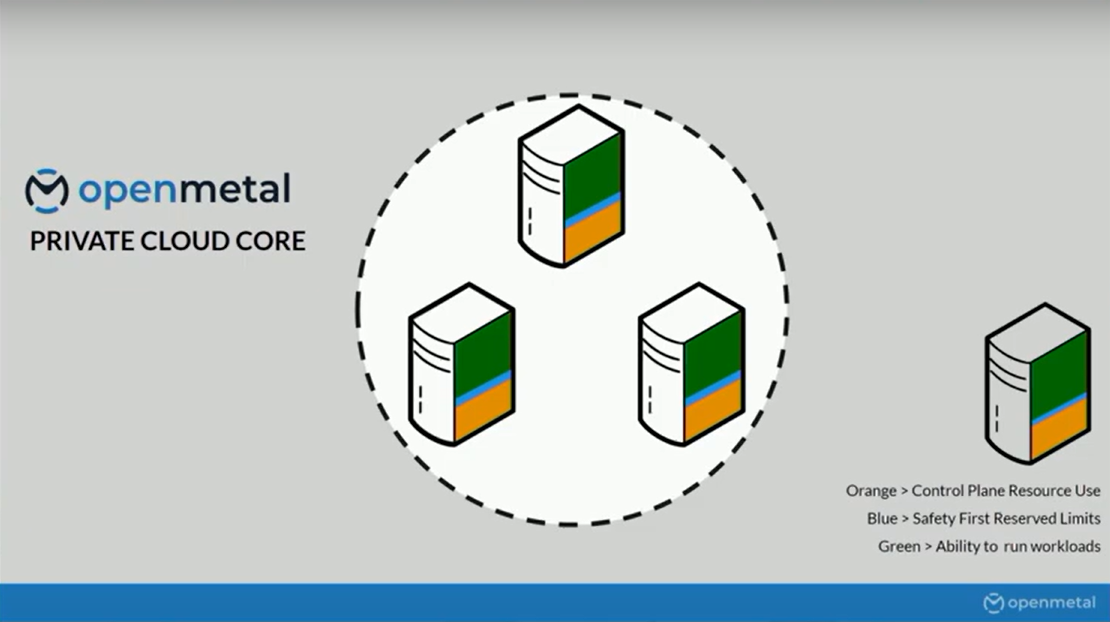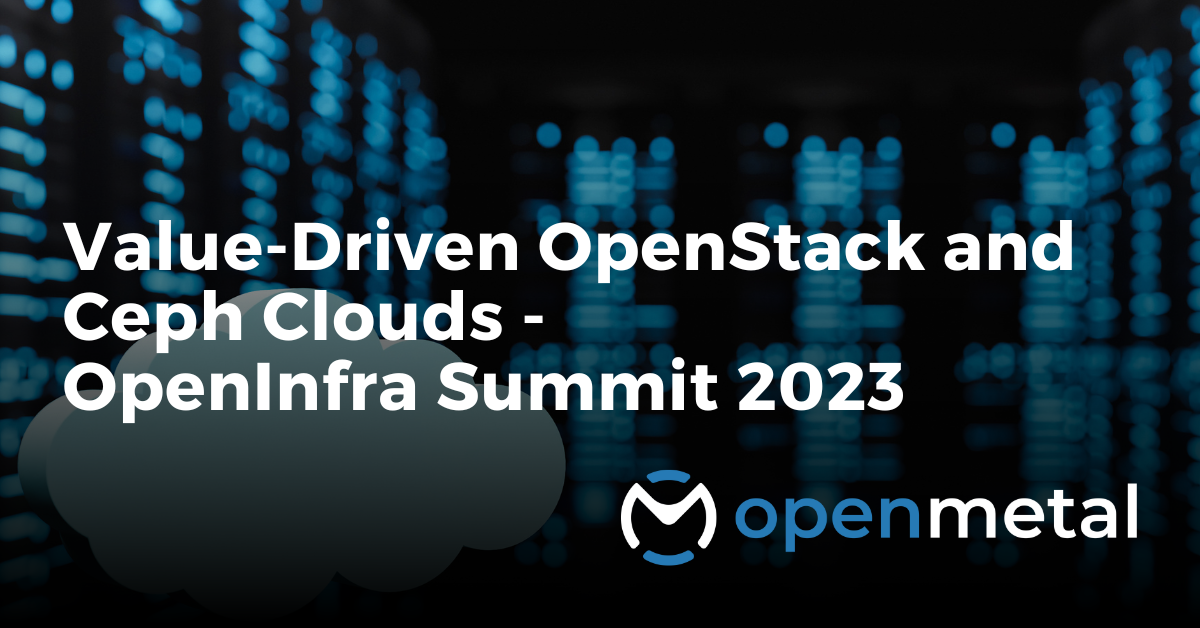In this video and accompanying article, OpenMetal Infrastructure and Platform Automations Engineer, Yuriy Shyyan, delves into the challenges and opportunities faced by growing businesses when it comes to cloud infrastructure costs and vendor dependency. While starting development in the public cloud is oftentimes logical, the escalating expenses and lack of flexibility become apparent as companies expand. The cost of idle resources and the impact on pricing goods or services creates a pressing need for alternative solutions, whether it’s for development, staging or production.
We present OpenStack and Ceph as powerful tools for creating personalized cloud environments. By embracing these open-source technologies, businesses can leverage the same capabilities offered by public clouds, including VMs, Object Storage, Kubernetes, Load Balancers, shared file systems, and key/value stores and more. With OpenStack and Ceph, organizations can regain control over their infrastructure, extracting more value than they could otherwise at no cost.
By understanding the underlying technology and owning the resources of the entire cloud footprint, businesses can leverage excess capacity at no additional cost. We emphasize that access to expertise and assistance shouldn’t be limited to industry giants but should be available to all, leveling the playing field.
Join us as we explore how OpenStack and Ceph clouds are effective solutions that empower businesses to escape vendor lock-in, reduce costs, and unlock the hidden potential of their own cloud environments. We discuss a safe landing footprint and a strategy for growth and scalability. Discover the freedom to innovate and the ability to tailor infrastructure to your specific needs, all while ensuring simplicity and scalability.
The below article is a transcription of the video content, edited minimally for clarity.
So this talk is about value-driven clouds powered by OpenStack and Ceph. It’s about a journey about how we have seen the value of clouds like that in the current economic market. It’s not a very technical talk but I hope it gives you some ideas and courage to try out OpenStack and Ceph-based clouds.
My name is Yuriy, I’m an Infrastructure and Platform Automations Engineer. I’m one of the original engineers for OpenMetal and I help people understand the value of our platform. Our mission is to basically automate and make highly complex open source systems available on demand in a turnkey solution and increase accessibility for the smaller teams.
Fun fact: we’re a silver member and an infrastructure donor to the OpenInfra Foundation so one of our clouds is actually used for CI/CD for Zuul to develop OpenStack.
What Makes a Cloud a Cloud in 2023?
So what makes a cloud a cloud in 2023? There’s bare minimums now:
- Highly available/resilient: It’s got to be highly available and failure tolerant.
- Distributed storage: You need the distributed storage to be able to mount the data from any location.
- On-demand workloads: You need to be able to create and destroy assets like networks and VMS or whole Kubernetes clusters at a whim.
- UI and API support: You need CLI tooling, and the UI component is important for visibility.
- Infrastructure as code automation support: You also want to support all the infrastructure as code automation so you need Terraform, and Ansible, and Heat, and all of those components.
- Contain commonly used features:
- VMs and container systems, live migrations
- LBaaS, FWaaS, NFSaaS
- Authentication (RBAC, user management, policy)
- Storage: block, object, K/V, NVMe direct, backups, snapshots
- Complex networks (VXLAN, VPNaaS, Routing…)
Fundamentally, you need to be able to run VMs, you need to be able to run containers, live migrations, support load balancers, firewall as a service, network file systems, a variety of storage, user management, and complex networks, and that is basically a bare minimum.
Driving OpenStack Demand
So we want OpenStack to be adopted by organizations of all sizes. How do we do that? Well, we listen to what they’re saying:
- They want to be able to know what they’re signing up for up front.
- They want to be able to use these clouds for dev, CI/CD, staging, production.
- They’re looking at alternatives to the public offerings.
- They’re very security aware.
- They want performance.
- They want to be able to monitor things like CPU frequencies if they need to.
- And they want uncomplicated billing mechanics.
Learning Versus Operating OpenStack
So there’s quite a few ways to learn OpenStack. At the keynote yesterday or on Tuesday they said about 50 of the people are new so if you haven’t checked out OpenStack, please do.
There’s definitely self-driven solutions, kind of like the DIY like DevStack, Microstack. There’s definitely official training sources; if your company uses OpenStack you can find those at the OpenStack marketplace. But people want learning environments that will match the production experience. They want to be able to test live migration, disaster recovery, development, all those things.
Tough concepts
Certain interesting things that we found are some tough concepts for cloud-native users to actually understand because they don’t have access to what happens under the hood, things like:
- Virtual limits versus actual real usage is not well understood.
- The ability to provision really big VMs and support burstability without having to actually use those resources.
- Instant sizing – everybody is shopping by public cloud instance sizes – when you own your own cloud you can create your own instance sizes.
- The over allocated resources, the ability to run 400 vCPUs on a 100 CPU box, something like that is also kind of a trick to explain.
Challenges of Landing an OpenStack Deployment
So some of the challenges that we’ve seen with landing an OpenStack deployment:
- Usually, if you’re building it out, it has a pretty high upfront cost.
- You have to probably take a month or two to properly deploy it, so there’s time to market delay considerations.
- And sometimes you need consultation and engineering experience.
- You need a safe path to land, figure it out, scale and grow.
- You want the access and ownership of your own data.
Soft Landing: The OpenMetal Private Cloud Core
We’ve created this kind of solution called a soft landing which is a Private Cloud Core, kind of a default landing footprint, that people can use right out of the box. It’s basically to get faster open source adoption and propel interest in this community. We want a turnkey solution accessible to mid-size and smaller teams that don’t have a big upfront budget.
It consists of three hyper-converged nodes, they basically run all the control plane services for both OpenStack and Ceph as well as some of the storage. So we deploy the control plane services and they consume some resources.
The control plane usage is fairly static to begin with and the quantity of the remaining resources depend on the unit size that you selected – if you have three servers and they all have a terabyte of RAM each, you’re going to have a lot of leftover things to play with. We also set some fair reserved limits for the control plane so that it operates well.
But all of those remaining resources in the white, well, those couldn’t be used and they can be used immediately. So the green here represents basically workloads you can run on that default landing footprint – whether it’s VMs, or Kubernetes clusters, complex networks, load balancers – the core is full of features that make a cloud a cloud.
Utilizing Cloud Core to run initial workloads
Now once you reach a point where you need more, you just add additional servers and grow your cloud on demand whenever you’re ready. And, they’re also converged, so they can expand storage and so on. And then you start running workloads on the compute nodes, on the converged compute nodes, and you can slowly start moving away some of those initial workloads from your control plane because it is a critical component of your cloud, so as your cloud grows you’ll want to move those out.
Cloud maturity
And then eventually you reach a mature cloud where most of the compute resources are moved off of the Cloud Core of the control plane servers and you’re basically running most of your workloads on the compute-added nodes. And the nice thing about the extra resources still available on the Cloud Core is they can be used as a failure tolerance mechanic, so there’s quite a bit of value in that.
Benefits and Considerations
So if you haven’t experienced OpenStack and Ceph we strongly recommend exploring them. You can get most of the features that you probably need from a cloud like that and there is no cost to try new things on your own cloud, so it reduces the barrier to innovate. You can try new Kubernetes cluster versions, new software, and so on.
There’s a flat, predictable billing model based on bare metal servers since this is basically what we are deploying to. Whether this is your on-prem deployment, or utilizing a company like us, the billing is radically different.
The other thing is it’s becoming fairly easy to deploy these private clouds, so the question is do you still need the one big cloud monolith? Or can you have many smaller clouds, VIP clouds, project clouds, department clouds, and so on? And the goal is that you land on an OpenStack and Ceph cloud safely and then expand.
Demo: Deploying a Private Cloud Core on OpenMetal
Skip to 9:20 in the accompanying video above to follow along with this demo.
So this is basically our control panel where we can spin up new clouds. I’m gonna spin up a little trial – select a location, and select one of the cloud cores. Again, very different sizes available. We’ll keep it in a trial, and now, we wait.
Our OpenStack cloud is ready, so we can check out the hardware. We use the smallest unit possible. This is a pretty good environment for learning, so they’re fairly small servers. We can go ahead and open Horizon, now we deploy a self-signed certificate, obviously everything’s customizable and configurable with OpenStack. We go ahead, go to our cloud, get our password.
Alright so we’re in our OpenStack deployment, backed by Ceph. We actually do preload all our clouds with some images and flavors. We pre-load some images, so the feeling is very natural to most cloud users. Here we can explore our hypervisors. Everything’s ready to go in a highly available, configured, production-ready format.
Powered by OpenStack
OpenMetal is a Silver Member of the OpenInfra Foundation. The OpenMetal Cloud platform is powered by OpenStack, one of the most supported and industry-accepted open source technologies for cloud infrastructure and infrastructure as a service.





































